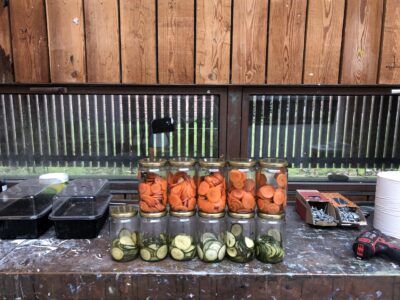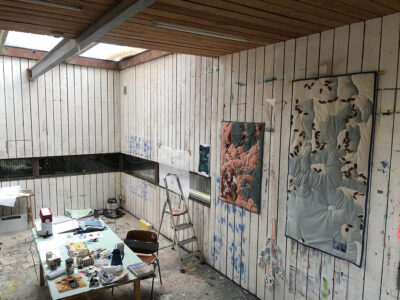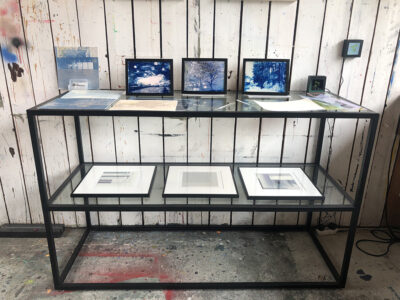30 November 2024
Interview
Not really together, but together in the same place. In conversation with Monika Dahlberg and Danielle Hoogendoorn
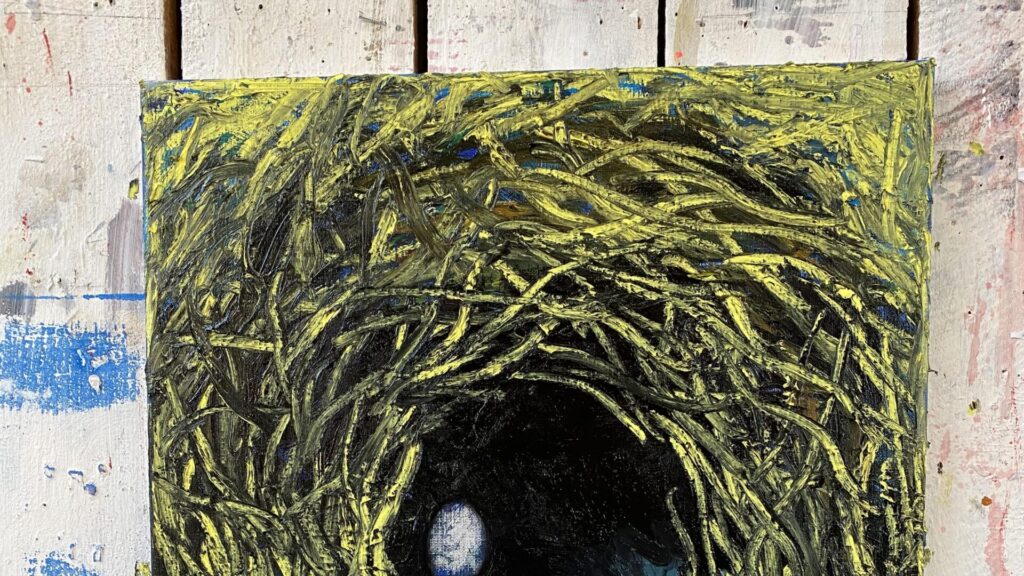
When Monika Dahlberg was invited by the Van Gogh House in Zundert to create a sculpture, everything fell into place. First of all, Monika needed a studio and a place to stay, so she invited herself to be Artist in Residence in the sexton’s house in Zundert for the month of November. In order to create a ceramic sculpture that could withstand wind and weather – and meet her aesthetic requirements – she needed help in the form of assistance from a craftswoman. Initially, Danielle Hoogendoorn was asked to share her knowledge and expertise, but her artistic practice prevented her from receiving a voucher from the Mondriaan Fund. That was no obstacle for Monika, who asked Danielle to come and work in the studio, if not with her, then alongside her.
Apparently, a lot happened before you could start your work period in Zundert. How did you like it?
M: I am so pleased to be returning home; I am completely exhausted here.
There is something oppressive about the people and the atmosphere. And then there is the church and the cemetery next door; on one side you have the team from the Van Gogh House and on the other side you have the team from the church, and the two do not match. They do not interact either. You can see that in the garden of the sexton’s house. One half is neat because the gardeners come very early in the morning and go to town with leaf blowers and noisy tools, it’s really awful. And the other side is maintained by the volunteers from the Van Gogh House, and it’s wild and just grows nicely.
The whole of Zundert is weird. There are gravestones in the village and they build houses and gardens around them; it’s just one big cemetery. There was something very heavy here, I didn’t dare to be happy here. There is also hardly any communication; people do make contact and then they say something nice to me about my clothes and then I say something back, but that’s not the point at all. They don’t really want to talk. For example, I went to the butcher’s here – I had heard from friends that it was the best butcher in Brabant – so I went there. They were very pleased to hear that compliment, but they didn’t stop and kept talking. It’s verbal hostage-taking.
D: I have been living in Brabant – in Loon op Zand – for four years now, and there is no dialogue there either. Only now are they asking, ‘What do you actually do?’ Here too, people are afraid to ask questions. But when you’re working here, people do look into the studio. They live nearby in sheltered accommodation or are visitors to the Van Gogh House. Those people expect there to be something to see. I also let in a class of schoolchildren who were standing in front of the window in the rain. Having a whole group inside like that wasn’t such a good idea. There was also a blind girl who had to be helped downstairs. Not at all convenient if you’re not prepared for it.
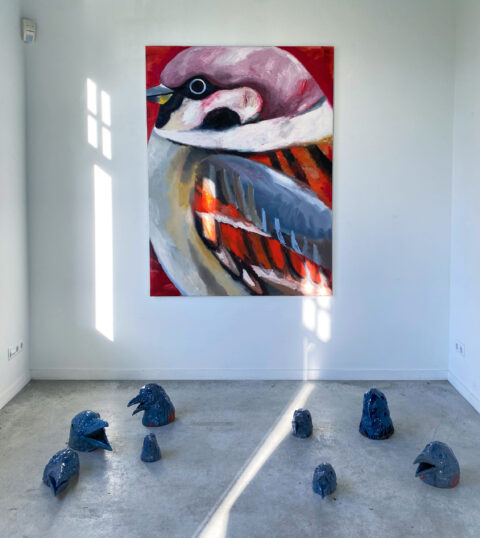
Photo of Danielle Hoogendoorn
So you were also here as ambassadors?
M: There’s always ambassadorial work to be done.
And now you’re here together as Artists in Residence, which wasn’t the original plan. How did that happen?
D: Monika was invited to create a sculpture for the garden, because there is also a whole garden at the Van Gogh House and almost no one knows that, so almost no one goes to see it. That garden needs to become more of a part of the house and will be turned into a sculpture garden where people can sit and look at art. I was going to accompany her during this work period as her supervisor for the technical process. That involved ceramics and the use of my kiln. A voucher was requested from the Mondriaan Fund for that, but I’m not a craftswoman – I’m an artist – so that wasn’t allowed.
M: But you are a craftswoman, aren’t you also a painter? That’s also a craft.
D: So that plan changed and a ceramist from Etten-Leur, Monique van de Ven, took on the role of craftswoman. But in the weeks leading up to it, we had already prepared so much that Monika took me along on her residency and allowed me into her aura.
M: I am now creating that image, but what you are doing here is more in line with Vincent’s fascination.
D: So I came here in a completely different way than usual, and also started to learn more about Vincent van Gogh. Beforehand, I watched a documentary about Vincent that was about a kind of pilgrimage to Arles, where he made all kinds of charcoal drawings. I planned to do something similar and went for a walk in the De Moeren estate, where I sank knee-deep into the mud. How romantic! I did start drawing there, but it just wasn’t that interesting. I’m not as good at drawing as Vincent. Then I discovered that he had a fascination with birds. Now I’m doing the same thing myself by protecting bird nests because I’ve moved to live in a forest. I’ve become completely absorbed in it by studying bird nests and have painted a whole series of just nests with eggs in them. I make a lot of them and then select from them. And the crows – I saw them in the field, a real nuisance – so they also reappear in the form of ceramic crow heads. And the dead sparrow, which Vincent also painted, I blew up on the canvas into a huge sparrow.
M: What fascinated me was whether Vincent took those nests with eggs and all. Was he interested in the birds, or in having those nests? What’s beautiful about your work is that your nests spin on the canvas; all those twigs that never lie still. Vincent did that too in Starry Night, with those spinning lines and the stars in the middle.
I have seen your nests many times. I would sit in the studio working – because she paints very quickly – with all those nests around me. And then I would sit there looking at them, and it was as if I was entering another dimension, not drugs or anything like that, but a kind of cosmos that I disappeared into the longer I looked at them…
D: It’s a follow-up to my chicken project, which I do at home. Some chickens lay blue eggs, others lay brown or white eggs, and so on. I crossbreed the chickens so that different colour combinations of eggs are produced. Ultimately, I want to have an egg box full of different coloured eggs. But I’m not allowed to bring any more chickens home. I often stopped by places on my way home from work where they had chickens I didn’t have yet. I would pick them up and hide them before secretly putting them in the chicken coop. There are already so many chickens, no one would notice a few more. But at a certain point, I started making more and more detours to pick up a few chickens that I could get through Marktplaats; that cost me more in fuel than the chickens were worth. So that got a bit out of hand. I also do all kinds of things with eggs: boiled eggs, fried eggs, I collect them, I paint them, I’m completely “egg-centric”. Vincent’s fascination with eggs – and mine – comes together here.
M: I don’t think it’s about the eggs for you, it’s more about the nests.

Photo of Danielle Hoogendoorn
D: It’s also about the effectiveness of painting; it has to be finished in one day, otherwise it won’t work. If I work on it for longer, it doesn’t turn out well, as you can see. I paint about five or six canvases a day.
M: What is long? I worked on one image for a whole month. The advantage of a residency is that you can work on something for longer. There’s nothing else to do here, so you have to. It’s necessary to work in a non-metropolitan area. It’s not very pleasant, but that’s good for concentration and for maintaining a very strict rhythm. I work for a few hours in the studio and in the evening I stop and watch Netflix. Those are my days. And in the morning I go to the café in Zundert where the women sit, and then I hear their stories about everything, especially traumas. It’s a good way to start the day. Then I go to work and in the dark I go back to the sexton’s house next to the studio.
I just didn’t have time for failures and spent a long time working on the basics. I made a lot of sketches in clay, and if they weren’t good, I threw them away. I had to, I just didn’t have the time to keep working on something for a long time, and eventually one of those sketches became the sculpture. It’s a bust, which was the plan. There are also a lot of volunteers here, and they all come by. One of them laughed a lot at my sculpture. I often incorporate humour, so when someone enjoys it, I know I’ve done something right.
The sculpture is about Vincent. It’s Vincent because it has a nose and a beard. I thought doing something with that ear would be a bit flat, so I just made a hole in his ear. Someone then said something about him being shot, something about Gauguin and a quarrel in Arles. You could see that as symbolic, but that’s not the intention. He’s also wearing a tie with Starry Night on it, which is also humour and symbolic. The back is also important; it’s a sculpture, so it’s three-dimensional, which means you have to make sure there’s something to look at there too. There you can now see a bottle of beer, a glass and a packet of cigarettes. The sculpture still needs to be fired and then it will be painted. You can find all the colours Vincent used on the internet, so I’ll choose from those. And a glacis layer is needed; it’s wet and damp here, so it’s better if it stands out because the garden itself doesn’t even stand out; no one goes there.
What I do is take up space as an artist in residence to create a sculpture. And then Danielle was here, but she was already practically living here, which is why we’re talking to you together. The plan was to work here together and put on an exhibition anyway, and that’s what we’re doing now.
D: We didn’t know each other beforehand, but we got to know each other.
M: We’re the first two people to be here together without it being a preconceived plan.
D: You have to be able to get along with each other.
M: It’s also nice that you do different things. It would have been possible to be here together anyway, even if I wasn’t creating a sculpture.
It could also go wrong…
M: That’s what makes it exciting, otherwise it’s boring. Vincent did the same thing with the yellow house, that idea of artists working together. Not really together, but together in the same place. Vincent also stole from others, ways of painting, subjects, colours. He was just an intense man who expected a lot from others.
D: The formula for success now is that we have no expectations. Gauguin was probably not an easy man, and neither was Vincent.

Photo of Esther van Rosmalen (from left to right: Monica Dahlberg – Danielle Hoogendoorn and Ron Dirven)
I believe there have also been recent stories about Gauguin that show him in a less favourable light.
M: Yes, but what am I supposed to do with all that information about Gauguin? It’s not going to make me think less of his paintings. If you knew everything about everyone, if you knew everything about me, you could think anything you wanted about my work, but is that so important? Can I suddenly stop liking something because of information that he was a bad person? He is a good artist, after all.
D: We need to separate the artist and their private life from their art, otherwise we could write everyone off. We all do things that can’t bear the light of day. It doesn’t make the work any worse. It seems as if we allow more when the artist is very important or popular. Take Michael Jackson, for example.
M: Do we need to know everything? There can be mystery too. We don’t know whether what happened in another time was wrong then either.
That’s interesting, because you’re both artists in a residency where everything revolves around the information available about a specific artist.
M: No, we don’t know anything about Vincent yet. It’s all snippets. It’s an act. Many artists have an act for the outside world, but inside they may be very different.
Esther van Rosmalen, November 2024

